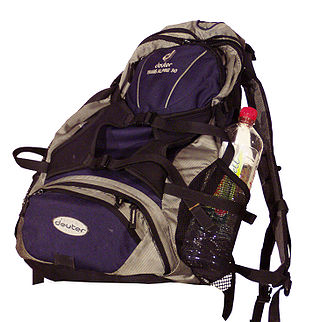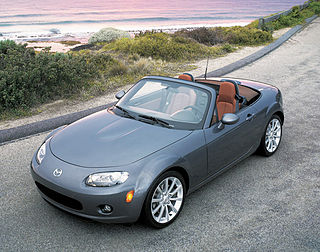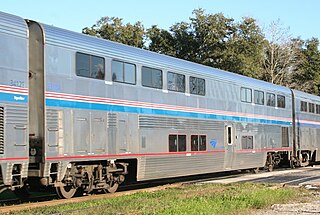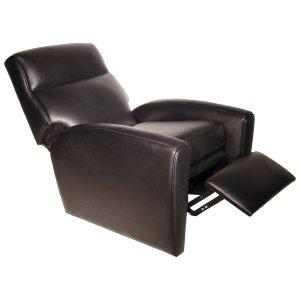
A backpack—also called knapsack, schoolbag,rucksack, rucksac, pack, sackpack, booksack, bookbag or backsack—is, in its simplest frameless form, a fabric sack carried on one's back and secured with two straps that go over the shoulders, but it can have an external frame, internal frame, and there are bodypacks.

A convertible or cabriolet is a passenger car that can be driven with or without a roof in place. The methods of retracting and storing the roof vary among eras and manufacturers.

Camping is a form of outdoor recreation involving overnight stays with a basic temporary shelter such as a tent. Camping can also include a recreational vehicle, a permanent tent, a shelter such as a bivy or tarp, or no shelter at all. Typically, participants leave developed areas to spend time outdoors, in pursuit of activities providing them enjoyment or an educational experience. Spending the night away from home distinguishes camping from day-tripping, picnicking, and other outdoor activities.

A tent is a shelter consisting of sheets of fabric or other material draped over, attached to a frame of poles or a supporting rope. While smaller tents may be free-standing or attached to the ground, large tents are usually anchored using guy ropes tied to stakes or tent pegs. First used as portable homes by nomads, tents are now more often used for recreational camping and as temporary shelters.

A pannier is a basket, bag, box, or similar container, carried in pairs either slung over the back of a beast of burden, or attached to the sides of a bicycle or motorcycle. The term derives from a Middle English borrowing of the Old French panier, meaning 'bread basket'.
There are many types of car body styles. They vary depending on intended use, market position, location, and the era they were made in.
A dining room is a room for consuming food. In modern times it is usually adjacent to the kitchen for convenience in serving, although in medieval times it was often on an entirely different floor level. Historically the dining room is furnished with a rather large dining table and several dining chairs; the most common shape is generally rectangular with two armed end chairs and an even number of un-armed side chairs along the long sides.

Backpacking is the outdoor recreation of carrying gear on one's back, while hiking for more than a day. It is often an extended journey, and may involve camping outdoors. In North America tenting is common, where simple shelters and mountain huts, widely found in Europe, are rare. In New Zealand, hiking is called tramping and tents are used alongside a nationwide network of huts. Hill walking is an equivalent in Britain, though backpackers make use of a variety of accommodation, in addition to camping. Backpackers use simple huts in South Africa. Trekking and bushwalking are other words used to describe such multi-day trips.

A paternal bond is the human bond between a father and his child.

A minibus, microbus, minicoach, or commuter is a passenger-carrying motor vehicle that is designed to carry more people than a multi-purpose vehicle or minivan, but fewer people than a full-size bus. In the United Kingdom, the word "minibus" is used to describe any full-sized passenger-carrying van or panel truck. Minibuses have a seating capacity of between 12 and 30 seats. Larger minibuses may be called midibuses. Minibuses are typically front engine step-in vehicles, although low floor minibuses are particularly common in Japan.

A passenger railroad car or passenger car, also called a passenger carriage, passenger coach, or passenger bogie is a railroad car that is designed to carry passengers. The term passenger car can also be associated with a sleeping car, a baggage car, a dining car, railway post office and prisoner transport cars.
In most patent laws, unity of invention is a formal administrative requirement that must be met for a patent application to proceed to grant. A patent application can basically relate only to one invention or a group of closely related inventions. The purpose of this requirement is administrative as well as financial. The requirement serves to preclude the option of filing one patent application for several inventions, while paying only one set of fees. Unity of invention also makes the classification of patent documents easier.

A deckchair is a folding chair, usually with a frame of treated wood or other material. The term now usually denotes a portable folding chair, with a single strip of fabric or vinyl forming the backrest and seat. It is meant for leisure, originally on the deck of an ocean liner or cruise ship. It is easily transportable and stackable, although some styles are notoriously difficult to fold and unfold. Different versions may have an extended seat, meant to be used as a leg rest, whose height may be adjustable; and may also have arm rests.

A high chair is a piece of furniture used for feeding older babies and younger toddlers. The seat is raised a fair distance from the ground, so that a person of adult height may spoon-feed the child comfortably from a standing position. It often has a wide base to increase stability. There is a tray which is attached to the arms of the high chair, which allows the adult to place the food on it for either the child to pick up and eat or for the food to be spoon-fed to them.

A child safety seat, sometimes called an infant safety seat, child restraint system, child seat, baby seat, car seat, or a booster seat, is a seat designed specifically to protect children from injury or death during vehicle collisions. Most commonly these seats are purchased and installed by car owners, but car manufacturers may integrate them directly into their vehicle's design and generally are required to provide anchors and ensure seat belt compatibility. Many jurisdictions require children defined by age, weight, and/or height to use a government-approved child safety seat when riding in a vehicle. Child safety seats provide passive restraints and must be properly used to be effective. However, research indicates that many child safety restraints are often not installed or used properly. To tackle this negative trend, health officials and child safety experts produce child safety videos to teach proper car seat installation to parents and caregivers.

A sofa bed or sofa-bed is a multifunctional furniture typically consisting of a sofa or couch that, underneath its seating cushions, hides a metal frame and thin mattress that can be unfolded or opened up to make a bed. A western-style futon differs from a sofa bed, although sofa beds using futon mattresses are common.

A recliner is an armchair or sofa that reclines when the occupant lowers the chair's back and raises its front. It has a backrest that can be tilted back, and often a footrest that may be extended by means of a lever on the side of the chair, or may extend automatically when the back is reclined.

Aro Manufacturing Co. v. Convertible Top Replacement Co., 365 U.S. 336 (1961), is a United States Supreme Court case in which the Court redefined the U.S. patent law doctrine of repair and reconstruction. The decision is sometimes referred to as Aro I because several years later the Supreme Court readdressed the same issues in a second case in 1964 involving the same parties—Aro II.

Scope mounts are used to attach telescopic sights or other types of sights to firearms. The scope sight itself is usually made for only one of two main types of mounts, which can be classified as scopes for ring mounts, for example a 30 mm tube, or scopes for rail mounts, such as the Zeiss rail. Words such as mounts and bases are used somewhat loosely, and can refer to several different parts which are either used together or in place of each other as ways to mount optical sights to firearms.
















